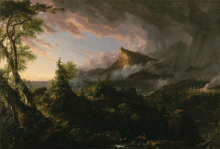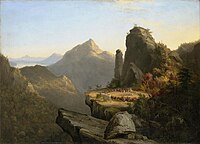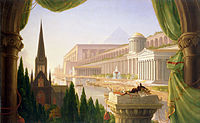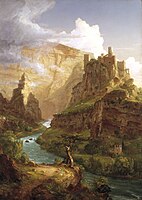art.wikisort.org - Artist
Thomas Cole (February 1, 1801 – February 11, 1848) was an English-American painter known for his landscape and history paintings. He is regarded as the founder of the Hudson River School,[1][2] an American art movement that flourished in the mid-19th century. Cole's work is known for its romantic portrayal of the American wilderness.[3]
Thomas Cole | |
|---|---|
 Thomas Cole, 1846 | |
| Born | February 1, 1801 Bolton le Moors, Lancashire, England |
| Died | February 11, 1848 (aged 47) Catskill, New York, U.S |
| Nationality | English, American |
| Known for | Painting Medium/Media: Oil on Canvas |
| Notable work | The Titan's Goblet (1833), The Course of Empire (1833–36), The Oxbow (1836), The Voyage of Life (1842) |
| Movement | Hudson River School |


Early life and education
Born in Bolton le Moors, Lancashire, in 1801,[4] Cole immigrated with his family to the United States in 1818, settling in Steubenville, Ohio. At the age of 22, he moved to Philadelphia and later, in 1825, to Catskill, New York, where he lived with his wife and children until his death in 1848.[5]
Cole found work early on as an engraver. He was largely self-taught as a painter, relying on books and by studying the work of other artists. In 1822, he started working as a portrait painter and later on, gradually shifted his focus to landscape.[6]
Painting

In New York, Cole sold five paintings to George W. Bruen, who financed a summer trip to the Hudson Valley where the artist produced landscapes featuring the Catskill Mountain House, the famous Kaaterskill Falls, the ruins of Fort Putnam, and two views of Cold Spring.[7][8] Returning to New York, he displayed five landscapes in the window of William Colman's bookstore; according to the New York Evening Post the two views of Cold Spring were purchased by Mr. A. Seton, who lent them to the American Academy of the Fine Arts annual exhibition in 1826. This garnered Cole the attention of John Trumbull, Asher B. Durand, and William Dunlap. Among the paintings was a landscape called View of Fort Ticonderoga from Gelyna. Trumbull was especially impressed with the work of the young artist and sought him out, bought one of his paintings, and put him into contact with a number of his wealthy friends[4] including Robert Gilmor of Baltimore and Daniel Wadsworth of Hartford, who became important patrons of the artist.
Cole was primarily a painter of landscapes, but he also painted allegorical works. The most famous of these are the five-part series, The Course of Empire, which depict the same landscape over generations—from a near state of nature to consummation of empire, and then decline and desolation—now in the collection of the New-York Historical Society and the four-part The Voyage of Life. There are two versions of the latter, one at the National Gallery in Washington, D.C., the other at the Munson-Williams-Proctor Arts Institute in Utica, New York. Among Cole's other famous works are The Oxbow (1836), The Notch of the White Mountains, Daniel Boone at his cabin at the Great Osage Lake, and Lake with Dead Trees (1825) which is at the Allen Memorial Art Museum.[9] He also painted The Garden of Eden (1828), with lavish detail of Adam and Eve living amid waterfalls, vivid plants, and deer.[10] In 2014, friezes painted by Cole on the walls of his home, which had been decorated over, were discovered.[11]
Cole influenced his peers in the art movement later termed the Hudson River School, especially Asher B. Durand and Frederic Edwin Church. Church studied with Cole from 1844 to 1846, where he learned Cole's technique of sketching from nature and later developing an idealized, finished composition; Cole's influence is particularly notable in Church's early paintings.[12] Cole spent the years 1829 to 1832 and 1841 to 1842 abroad, mainly in England and Italy.[4]
Other work
Cole is best known for his work as an American landscape artist. In an 1836[13] article on "American Scenery",[14] he described his complex relationship with the American landscape in esthetic, emotional, and spiritual terms. He also produced thousands of sketches of varying subject matter. Over 2,500 of these sketches can be seen at The Detroit Institute of Arts.,
In 1842, Cole embarked on a Grand Tour of Europe in an effort to study in the style of the Old Masters and to paint its scenery. Most striking to Cole was Europe's tallest active volcano, Mount Etna. Cole was so moved by the volcano's beauty that he produced several sketches and at least six paintings of it.[15] The most famous of these works is A View from Mount Etna from Taormina which is a 78-by-120-inch (1,980 by 3,050 mm) oil on canvas. Cole also produced a highly detailed sketch View of Mount Etna which shows a panoramic view of the volcano with the crumbling walls of the ancient Greek theater of Taormina on the far right.
Cole was also a poet and dabbled in architecture, a not uncommon practice at the time when the profession was not so codified. Cole was an entrant in the design competition held in 1838 to create the Ohio Statehouse in Columbus, Ohio. His entry won third place, and many contend that the finished building, a composite of the first, second, and third-place entries, bears a great similarity to Cole's entry.[16]
Personal life
After 1827 Cole maintained a studio at the farm called Cedar Grove, in the town of Catskill, New York. He painted a significant portion of his work in this studio. In 1836, he married Maria Bartow of Catskill, a niece of the owner's, and became a year-round resident. Thomas and Maria had five children.[17] Cole's daughter Emily was a botanical artist who worked in watercolor and painted porcelain.[18] Cole's sister, Sarah Cole, was also a landscape painter.
Additionally, Cole held many friendships with important figures in the art world including Daniel Wadsworth, with whom he shared a close friendship. Proof of this friendship can be seen in the letters that were unearthed in the 1980s by the Trinity College Watkinson Library. Cole emotionally wrote Wadsworth in July 1832: "Years have passed away since I saw you & time & the world have undoubtedly wrought many changes in both of us; but the recollection of your friendship... [has] never faded in my mind & I look at those pleasures as 'flowers that never will in other garden grow-'"[19] Thomas Cole died at Catskill on February 11, 1848, of pleurisy.[20] The fourth highest peak in the Catskills is named Thomas Cole Mountain in his honor.[21] Cedar Grove, also known as the Thomas Cole House, was declared a National Historic Site in 1999 and is now open to the public.[22]
Selected works
- Imaginary scene from The Last of the Mohicans (1827), Wadsworth Atheneum
- Distant View of Niagara Falls (1830), Art Institute of Chicago[23]
- Romantic Landscape with Ruined Tower (1832–36), Albany Institute of History & Art
- The Course of Empire: The Savage State (1836), New-York Historical Society
- The Course of Empire: Consummation (1835–1836), New-York Historical Society
- The Course of Empire: Destruction (1836), New-York Historical Society
- The Course of Empire: Desolation (1836), New-York Historical Society
- The Fountain of Vaucluse (1841), Dallas Museum of Art
- Temple of Segesta (1843), Museum of Fine Arts, Boston
- A View of the Two Lakes and Mountain House, Catskill Mountains, Morning (c. 1844), Brooklyn Museum
- Il Penseroso (1845), Los Angeles County Museum of Art
 Home in the Woods (1847), Reynolda House Museum of American Art
Home in the Woods (1847), Reynolda House Museum of American Art- Prometheus Bound (1847), Fine Arts Museums of San Francisco
See also
References
- Hanc, John (October 23, 2017). "'Scenes of Solitude' From Hudson River School Artists". The New York Times. Archived from the original on November 29, 2018. Retrieved November 28, 2018.
- Avery, Kevin J. (October 2004). "The Hudson River School". Metropolitan Museum of Art. Archived from the original on March 2, 2019. Retrieved November 28, 2018.
- Truettner, William H. (1994). Thomas Cole: Landscape into History. New Haven and London: Yale University Press.
- Chisholm 1911.
- Tour brochure, Thomas Cole House, Catskill NY.Truettner, William H.; Wallach, Alan (1994). Thomas Cole Landscape into History. New Haven and London: Yale University Press. p. 8.
- Truettner, William H. (1994). Thomas Cole: Landscape into History. New Haven and London: Yale University Press. pp. 25–26.
- Effmann, Elise (November 2004). "Thomas Cole's View of Fort Putnam" (PDF). The Magazine Antiques: 154–159. Retrieved September 9, 2013.
- http://hamiltonauctiongalleries.com/COLE-T25FP.JPG [bare URL image file]
- Brophy, Alfred L. (2009). "Property and Progress: Antebellum Landscape Art and Property Law" (PDF). McGeorge Law Review. 40: 605–59. Retrieved March 26, 2014.
- Exhibit at the Amon Carter Museum in Fort Worth, Texas
- Schweber, Nate (July 1, 2015). "Unknown Thomas Cole Paintings Found at His Home". The New York Times. Retrieved July 3, 2015.
- Howat, John K. (2005). Frederic Church. New Haven: Yale University Press. pp. 9–12. ISBN 978-0300109887.
- "American Scenery--Thomas Cole vs NASA".
- Cole, Thomas (January 1836). "American Scenery". The American Monthly Magazine. 1 (1): 1–12.
- "Studies on Thomas Cole" Baltimore Museum of Art, Annual II. pp. 123. Baltimore, Maryland 1967.
- Weidman, Jeffrey; Library, Oberlin College (2000). Artists in Ohio, 1787–1900: A Biographical Dictionary. Kent State University Press. p. 174. ISBN 978-0-87338-616-6.
- They were: Theodore Alexander Cole, born January 1, 1838; Mary Bartow Cole, born September 23, 1839; Emily Cole, born August 27, 1843; Elizabeth Cole, born April 5, 1847 (died in infancy); Thomas Cole Jr., born September 16, 1848. ("A Guide to the Thomas Cole Collection" (PDF). Albany Institute of History and Art. p. 9. Archived from the original (PDF) on November 20, 2008. Retrieved January 6, 2009.)
- "The Art of Emily Cole". Thomas Cole National Historic Site. Retrieved April 15, 2020.
- Cole, T., & Wadsworth, D. (1983). The correspondence of Thomas Cole and Daniel Wadsworth: Letters in the Watkinson Library, Trinity College, Hartford, and in the New York State Library, Albany, New York. Hartford, Conn.: Connecticut Historical Society.
- "Biography of Thomas Cole". Thomas Cole National Historic Site.
- "Cedar Grove History". Thomascole.org. Archived from the original on January 6, 2014. Retrieved March 26, 2014.
- "History of Cedar Grove". The Thomas Cole National Historic Site. Archived from the original on October 18, 2007. Retrieved October 30, 2007.
- Cole, Thomas. "Distant View of Niagara Falls". The Art Institute of Chicago. Retrieved May 24, 2021.
Other sources
- Chisholm, Hugh, ed. (1911). . Encyclopædia Britannica. Vol. 6 (11th ed.). Cambridge University Press. p. 665.
External links
![]() Media related to Thomas Cole at Wikimedia Commons
Media related to Thomas Cole at Wikimedia Commons
| External video | |
|---|---|
 | |
- Cedar Grove – The Thomas Cole National Historical Site in Catskill, NY
- Thomas Cole at Find a Grave
- Works by Thomas Cole at the Cincinnati Art Museum
- White Mountain paintings by Thomas Cole
- Reynolda House Museum of American Art
- Information about Thomas Cole can be found in the Thomas Cole Collection, which contains correspondence, financial and legal documents, clippings, exhibition catalogs, poems related to him and his family, in the Albany Institute of History & Art Library.
- Thomas A. Cole Papers, 1821–1863. This finding aid contains biographical information about Cole and describes the collection of his papers (correspondence, journals, notebooks, essays and poetry) held by the New York State Library.
- Thomas Cole's Journal, 1834–1848. The journal, which was digitized by the New York State Library, contains scattered handwritten entries from November 5, 1834, through February 1, 1848.
- Art and the empire city: New York, 1825–1861, an exhibition catalog from The Metropolitan Museum of Art (fully available online as PDF), which contains material on Thomas Cole (see index)
- American paradise: the world of the Hudson River school, an exhibition catalog from The Metropolitan Museum of Art (fully available online as PDF), which contains material on Thomas Cole (see index)
- Hudson River school visions: the landscapes of Sanford R. Gifford, an exhibition catalog from The Metropolitan Museum of Art (fully available online as PDF), which contains paintings by and material on Cole (see index)
- American Scenery, by Thomas Cole Full text with introduction
- Works by Thomas Cole at LibriVox (public domain audiobooks)

На других языках
[de] Thomas Cole
Thomas Cole (* 1. Februar 1801 in Bolton, Lancashire; † 11. Februar 1848 in Catskills, New York) war ein in England geborener US-amerikanischer Maler. Er gilt als Begründer und bedeutendster Vertreter der Hudson River School, einer Gruppe amerikanischer Künstler in der Mitte des 19. Jahrhunderts, die bekannt wurde für die genaue, detailreiche Wiedergabe amerikanischer Landschaften, häufig verbunden mit historischen und allegorischen Bildthemen.- [en] Thomas Cole
[es] Thomas Cole
Error de Lua en Módulo:Ficha en la línea 379: attempt to concatenate field 'claseimagen' (a nil value). Thomas Cole (Bolton le Moors, Lancashire, Inglaterra, 1 de febrero de 1801-Catskill, Nueva York, 11 de febrero de 1848) fue un pintor estadounidense de origen británico, fundador de la Escuela del río Hudson. Establecido en Nueva York en 1825, empezó a pintar paisajes de la zona del río Hudson, con el objetivo de lograr «un estilo elevado de paisaje» en el que el mensaje moral fuese equivalente al de la pintura de historia. Pintó también temas bíblicos.[1][fr] Thomas Cole
Thomas Cole, né le 1er février 1801 à Bolton, Angleterre et mort le 11 février 1848 à Catskill, État de New York, est un artiste américain du XIXe siècle. Il est considéré comme le fondateur de la Hudson River School, école de peinture qui s'épanouit aux États-Unis dans la seconde moitié du XIXe siècle. Les œuvres de Cole et ses amis se caractérisent par leur rendu réaliste et minutieux des paysages américains, notamment des régions sauvages, et témoignent à la fois de l'influence du romantisme et du naturalisme[1].[it] Thomas Cole
Thomas Cole (Bolton, 1º febbraio 1801 – Catskill, 11 febbraio 1848) è stato un pittore inglese naturalizzato statunitense.[ru] Коул, Томас
То́мас Ко́ул[8] (англ. Thomas Cole; 1 февраля 1801 — 11 февраля 1848) — американский художник-пейзажист, основатель Школы реки Гудзон, одной из наиболее влиятельных школ живописи США XIX века.Другой контент может иметь иную лицензию. Перед использованием материалов сайта WikiSort.org внимательно изучите правила лицензирования конкретных элементов наполнения сайта.
WikiSort.org - проект по пересортировке и дополнению контента Википедии



![Distant View of Niagara Falls (1830), Art Institute of Chicago[23]](http://upload.wikimedia.org/wikipedia/commons/thumb/8/85/Distant_View_of_Niagara_Falls_1830_Thomas_Cole.jpg/200px-Distant_View_of_Niagara_Falls_1830_Thomas_Cole.jpg)











